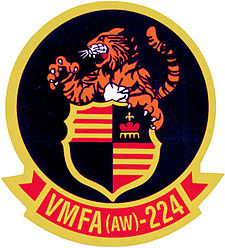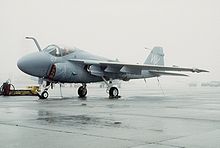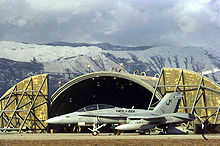- VMFA(AW)-224
-
Marine Corps All Weather Fighter Attack Squadron 224 
Active May 1, 1942 - present Country United States Allegiance United States of America Branch United States Marine Corps Type All Weather Fighter/Attack Role Close air support
Air interdiction
Aerial reconnaissancePart of Marine Aircraft Group 31
2nd Marine Aircraft WingGarrison/HQ Marine Corps Air Station Beaufort Nickname "Fighting Bengals"
Fighting Wildcats (WWII)[1]Tail Code WK Engagements World War II
* Battle of Guadalcanal
* Battle of Okinawa
Vietnam War
Operation Desert Storm
Operation Joint Endeavor
Operation Iraqi FreedomCommanders Current
commanderLtCol Peter L. McArdle Aircraft flown Attack A4D Skyhawk
A-6 IntruderFighter F4F Wildcat
F4U Corsair
F2H-2 Banshee
F9F Panther
F/A-18D HornetMarine All Weather Fighter Attack Squadron 224 (VMFA(AW)-224) is a United States Marine Corps F/A-18 Hornet squadron. Also known as the "Bengals", the squadron is based at Marine Corps Air Station Beaufort, South Carolina and falls under the command of Marine Aircraft Group 31 (MAG-31) and the 2nd Marine Aircraft Wing (2nd MAW).
Contents
Mission
Attack and destroy surface targets, day or night, under the weather; conduct multi-sensor imagery reconnaissance; provide supporting arms coordination; and intercept and destroy enemy aircraft under all-weather conditions.
History
World War II
Marine Fighter Squadron 224 (VMF-224) was commissioned on May 1, 1942 at Naval Air Station Barbers Point, Hawaii. Flying Grumman F4F Wildcats, the Bengals entered World War II as part of the Cactus Air Force stationed on Henderson Field, Guadalcanal. Led by Medal of Honor recipient Maj Robert Galer, the squadron accounted for over sixty Japanese aircraft being destroyed in less than two months. The squadron also conducted close air support (CAS) missions while under constant attack from Japanese naval, air, and ground forces. VMF-224’s contributed significantly to the American victory during the Guadalcanal Campaign, which in turn, helped stem the tide of the Japanese advance across the Southern Pacific and secured a crucial foothold in the long island-hopping campaign against Japan.
After Guadalcanal, the squadron was refitted with the Vought F4U Corsair and participated in the Marshall Islands Campaign. The spring of 1945 found VMF-224 participating in the last great battle of the Pacific Campaign. During the Battle of Okinawa the squadron operated for the duration of the campaign from the newly captured airfield at Yomitan. Throughout the struggle for Okinawa, the Bengals flew infantry support and counter air missions accounting for an additional fifty-five enemy aircraft being destroyed.
1950s - 1970s
The squadron entered the jet era in 1951 with the acceptance of the F2H-2 Banshee. In 1952, after completing a Mediterranean Cruise aboard the USS Roosevelt, the squadron accepted the Grumman F9F Panther, and was re-designated Marine Attack Squadron 224 (VMA-224).
On September 29, 1956, the squadron became the first Marine unit to field the A4D Skyhawk aircraft[2].[3] In 1965, the Bengals deployed to South Vietnam as part of the United States' buidup during the Vietnam War. For nearly a year the Bengals operated their “Scooters” from the expeditionary field at Chu Lai. On November 1, 1966, the squadron acquired the Grumman A-6 Intruder and was re-designated as Marine All Weather Attack Squadron 224 (VMA(AW)-224). In 1971, the Bengals deployed to the South China Sea aboard the USS Coral Sea (CV-43). As part of Carrier Air Wing 15, the squadron completed six line periods on Yankee Station and participated in numerous operations including the historic mining of Hai Phong Harbor.
The Gulf War & the 1990s
 An A-6 Intruder from VMA(AW)-224 on the flightline at MCAS Cherry Point in 1984.
An A-6 Intruder from VMA(AW)-224 on the flightline at MCAS Cherry Point in 1984.
The Bengals deployed to Southwest Asia, on August 28, 1990. Operating from Shaikh-Isa Air Base, Bahrain the squadron participated in Operation Desert Shield. From January 16, to February 28, 1991, the Bengals participated in Operation Desert Storm, expending more than 2.3 million pounds of ordnance during 422 combat sorties.
Shortly after their return to Marine Corps Air Station Cherry Point, North Carolina, on May 24, 1992, the Bengals celebrated their 50th anniversary. Less than a year later on March 5, 1993, the squadron was re-designated VMFA(AW)-224 and moved to Marine Corps Air Station Beaufort, South Carolina where the Bengals received the multi-mission F/A-18D Hornet.
From April to September 1994 the Bengals deployed to Aviano, Italy, as part of the United Nations force for Operation Deny Flight and Operation Provide Promise in Bosnia-Herzegovina. The squadron flew 1150 sorties for 3485 flight hours including 1150 night hours. The Marines of VMFA(AW)-224 again deployed to Aviano, Italy in September 1995, as part of NATO Operation Deliberate Force and Operation Joint Endeavor.
Global War on Terror
On January 11, 2005, VMFA(AW)-224 deployed to Al Asad Airbase, Iraq in support of Operation Iraqi Freedom (OIF). While in support of OIF, the Bengals employed 65,225 lb of ordnance and flew over 2500 sorties and 7000 hours in direct support of Marine, Army and Coalition ground units. On March 12, 2010 an F/A-18D Hornet from the squadron crashed 35 miles off the coast of St. Helena Sound north of Beaufort due to an engine fire. The pilot and Weapons Systems Officer were able to safely eject.[4]
Misc
See also
- United States Marine Corps Aviation
- List of active United States Marine Corps aircraft squadrons
- List of inactive United States Marine Corps aircraft squadrons
Notes
- ^ DeChant (1947), p.225.
- ^ "McDONNELL-DOUGLAS A-4M "SKYHAWK"". Flying Leatherneck Historical Foundation and Aviation Museum. http://www.flyingleathernecks.org/jets.html#skyhawk. Retrieved 2007-12-16.
- ^ SKYHAWK - "FIRST & LAST" MILESTONES
- ^ 2 Marine fighter pilots rescued; SC crash probed
References
 This article incorporates public domain material from websites or documents of the United States Marine Corps.
This article incorporates public domain material from websites or documents of the United States Marine Corps.
- Bibliography
- De Chant, John A. (1947). Devilbirds - The Story of United States Marine Aviation in World War II. New York: Harper & Brothers. pp. 4–5.
- Rottman, Gordon L. (2002). U.S. Marine Corps World War II Order of Battle - Ground and Air Units in the Pacific War, 1939 - 1945.’’. Greenwood Press. ISBN 0-313-31906-5.
- Sherrod, Robert (1952). History of Marine Corps Aviation in World War II. Washington, D.C.: Combat Forces Press.
- Web
External links
MAG-14 
MAG-26 MAG-29 MAG-31 MACG-28 MWSG-27 Categories:- United States Marine Corps fixed wing squadrons
Wikimedia Foundation. 2010.





